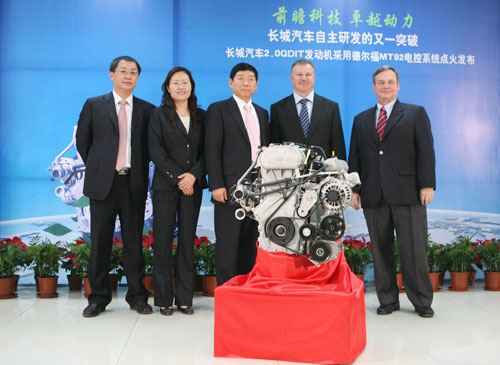

2.0GDIT Gasoline Engine of Great Wall Motors Was Successfully Ignited
On October 16th, 2.0GDIT gasoline engine -- another gasoline-powered unit with mid-level emission and high power was successfully ignited in Power Research Institute of Great Wall Motor. This is another achievement made in motor engine after GW4D20 diesel-powered engine went to market four days ago.
On October 16th, 2.0GDIT gasoline engine -- another gasoline-powered unit with mid-level emission and high power was successfully ignited in Power Research Institute of Great Wall Motor. This is another achievement made in motor engine after GW4D20 diesel-powered engine went to market four days ago. The power performance indicators of the engine are improved by 50% compared to that of traditional 2.0L engine and the fuel consumption is reduced by 15%, and its emission meets Euro V emission standard, reaching a level above the EU V+ standard.
Brian Lower, president of Delphi Asia Pacific, the key technology partner, engine experts, and some media attended the lighting ceremony, witnessed the latest achievement of independent innovation of Great Wall Motor. Not long ago, GW4D20 diesel-powered passenger vehicle, another new R & D achievement of Great Wall Motor, was put on the market. It has made breakthroughs in four international indicators, including automobile emission, power per liter, torque per liter, noise and energy saving as well as low consumption, highly appraised by engine experts. The successful ignition of 2.0GDIT gasoline engine marks another new breakthrough made by Great Wall Motor in engine development.

Low Emission, High-power, Applied Eight Advanced Core Technologies.
2.0GDIT is a 4-cylinder and 16-valve engine, applied 8 latest technologies, including fuel direct injection, exhaust turbocharger, intake and exhaust VVT, high-performance valve actuating mechanism, timing toothed silent chain, two sided balance shaft, sodium refilling valve, and high performance piston rod.
Fuel direct injection technology applies 150bar injection pressure to ensure high quality fuel atomization, greatly improving the fuel economy and cold starting performance of the engine. By using the exhaust energy, exhaust turbocharger technology improves the inlet pressure of the engine and thereby improve the power and torque of the engine. Intake and exhaust VVT increases the intake air and reduces the residual gas, improving idle stability. High Performance valve actuating mechanism is applied dual overhead camshaft. The hydraulic lifter automatically adjusts the valve clearance to zero, eliminating the noise caused by the valve clearance, and effectively improving engine power torque. Timing toothed silent chain effectively improves the noise-damping performance of the engine. Two sided balance shaft plays a role in stabilizing the fluctuations of inertia moment. The sodium refilling valve reduces the valve weight by 6%, effectively reducing reciprocating inertia force of valve, thus achieving a better thermal balance. The high performance piston rod adopts lightweight design, which reduces the weight by about 10%, thus reducing the fuel consumption and improving the overall performance of NVH. Inflation rod significantly improves the reliability of system.
The power of 2.0GDIT gasoline engine is 160kW and the torque is 324Nm, which is much better than similar domestic engines. Guaranteed by the first-class production facilities, it will surely become a leading product in intermediate passenger vehicle engines. It only took Great Wall Motor 9 months to complete the research and development of 2.0GDIT gasoline engine project , which even deeply surprised Rod Rosie, the power assembly engineering director of Delphi in Asia Pacific region.
It is reported that 2.0GDIT gasoline engine has already started to develop the engine performance combined with vehicle operation and is expected to appear in market in 2012, which will mainly be applied in the power matching of high-end SUV, C-class passenger car and commercial vehicle.